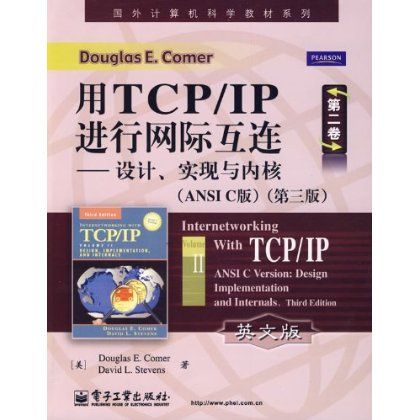《用TCP·IP進行網際互連第2卷:設計、實現與核心》是2009年8月1日電子工業出版社出版的圖書,作者是(美國)科默 (美國)史蒂文。
基本介紹
- 書名:用TCP·IP進行網際互連第2卷:設計、實現與核心
- ISBN:9787121091889
- 出版社:電子工業出版社
- 出版時間:2009年8月1日
圖書信息,作者簡介,內容簡介,目錄,
圖書信息
出版社: 電子工業出版社; 第3版 (2009年8月1日)
叢書名: 國外計算機科學教材系列
平裝: 660頁
正文語種: 簡體中文
開本: 16
ISBN: 9787121091889
條形碼: 9787121091889
尺寸: 23.2 x 18.4 x 2.8 cm
重量: 939 g
作者簡介
作者:(美國)科默 (美國)史蒂文
Douglas E.Comer:普度大學的一位傑出的計算機科學教授,思科系統公司的訪問教授成員,並且是計算機網路和TCP/IP以及網際網路方面的國際公認的專家。他的著作已翻譯成16種語言,並廣泛用於世界各地的工業界和學術界。作為他的得意之作,這套共分三卷的《用TcP/IP進行網際互連》徹底改變了組網和網路方面的教育,並且他的不斷創新的工作繼續影響著研究生和大學生所學的課程。作為美國計算機學會的會士,在他獲得的許多榮譽中包括Usenix終生成就獎。
內容簡介
《用TCP/IP進行網際互連第2卷:設計、實現與核心(ANSI C版)(第3版)(英文版)》是關於計算機網路的經典教材,是目前美國大多數大學所開設的計算機網路課程的主要參考書。全書共三卷。第二卷在第一卷介紹了TCP/IP基本概念的基礎上,進一步詳細討論了TCP/IP的實現細節。這一卷的突出特點 非常注重實際。作者利用程式代碼實現了TCP/IP的每個技術細節,並且所有代碼在書中均可找到,有助於讀者深入了解並掌握TCP/IP的細節內容。書中附錄分別給出了過程調用交叉參考表、程式代碼中用到的C數據結構交叉參考表及Xinu函式和常量。
目錄
Foreword
Preface
Chapter 1 Introduction And Overview
1.1 TCP/IP Protocols
1.2 The Need To Understand Details
1.3 Complexity Of Interactions Among Protocols
1,4 The Approach In This Text
1.5 The Importance Of Studying Code
1.6 The Xinu Operating System
1.7 Organization Of The Remainder Of The Book
1.8 Summary
Chapter 2 The Structure Of TCP/IP Software In An Operating System
2.1 Introduction
2.2 The Process Concept
2.3 Process Priority
2.4 Process Synchronization
2.5 lnterprocess Communication
2.6 Device Drivers, Input, And Output
2.7 Network Input and Interrupts
2.8 Passing Packets To Higher Level Protocols
2.9 Passing Datagrams From IP To Transport Protocols
2.10 Delivery To Application Programs
2.11 Information Flow On Output
2.12 From TCP Through IP To Network Output
2.13 UDP Output
2.14 Summary
Chapter 3 Network Interface Layer
3.1 Introduction
3.2 The Network Interface Abstraction
3.3 Ethernet Definitions
3.4 Logical State Of An Interface
3.5 Local Host Interface
3.6 Buffer Management
3.7 Demultiplexing Incoming Packets
3.8 Summary
Chapter 4 Address Discovery And Binding (ARP)
4.1 Introduction
4.2 Conceptual Organization Of ARP Software
4.3 Example ARP Design
4.4 Data Structures For The ARP Cache
4.5 ARP Output Processing
4.6 ARP Input Processing
4.7 ARP Cache Management
4.8 ARP Initialization
4.9 ARP Configuration Parameters
4.10 Summary
Chapter 5 IP: Global Software Organization
5.1 Introduction
5.2 The Central Switch
5.3 IP Software Design
5.4 IP Software Organization And Datagram Flow
5.5 Byte-Ordering In The IP Header
5.6 Sending A Datagram To IP
5.7 Table Maintenance
5.8 Summary
Chapter 6 IP: Routing Table And Routing Algorithm
6.1 Introduction
6.2 Route Maintenance And Lookup
6.3 Routing Table Organization
6.4 Routing Table Data Structures
6.5 Origin Of Routes And Persistence
6.6 Routing A Datagram
6.7 Periodic Routing Table Maintenance
6.8 IP Options Processing
6.9 Summary
Chapter 7 IP: Fragmentation And Reessembly
7.1 Introduction 109
7.2 Fragmenting Datagrams
7.3 Implementation Of Fragmentation
7.4 Datagram Reassembly
7.5 Maintenance Of Fragment Lists
7.6 Initialization
7.7 Summary
Chapter 8 IP: Error Processing (ICMP)
8.1 Introduction
8.2 ICMP Message Formats
8.3 Implementation Of ICMP Messages
8.4 Handling Incoming ICMP Messages
8.5 Handling An ICMP Redirect Message
8.6 Setting A Subnet Mask
8.7 Choosing A Source Address For An ICMP Packet
8.8 Generating ICMP Error Messages
8.9 Avoiding Errors About Errors
8.10 Allocating A Buffer For ICMP
8.11 The Data Portion Of An ICMP Message
8.12 Generating An ICMP Redirect Message
8.13 Summary
Chapter 9 IP: Multicast Processing (IGMP)
9.1 Introduction
9.2 Maintaining Multicast Group Membership Information
9.3 A Host Group Table
9.4 Searching For A Host Group
9.5 Adding A Host Group Entry To The Table
9.6 Configuring The Network Interface For A Multicast Address
9.7 Translation Between IP and Hardware Multicast Addresses
9.8 Removing A Multicast Address From The Host Group Table
9.9 Joining A Host Group
9.10 Maintaining Contact With A Multicast Router
9.11 Implementing IGMP Membership Reports
9.12 Computing A Random Delay
9.13 A Process To Send IGMP Reports
9.14 Handling Incoming IGMP Messages
9.15 Leaving A Host Group
9.16 Initialization Of IGMP Data Structures
9.17 Summary
Chapter 10 UDP: User Datagrams
10.1 Introduction
10.2 UDP Ports And Demultiplexing
10.3 UDP Input Processing
10.4 UDP Output Processing
10.5 Summary
Chapter 11 TCP: Data Structures And Input Processing
11.1 Introduction
11.2 Overview Of TCP Software
11.3 Transmission Control Blocks
11.4 TCP Segment Format
11.5 Sequence Space Comparison
11.6 TCP Finite State Machine
11.7 Example State Transition
11.8 Declaration Of The Finite State Machine
11.9 TCB Allocation And Initialization
11.10 Implementation Of The Finite State Machine
11.11 Handling An Input Segment
Chapter 12 TCP: Finite State Machine Implementation
12.1 Introduction
12.2 CLOSED State Processing
12.3 Graceful Shutdown
12.4 Timed Delay After Closing
12.5 TIME-WAIT State Processing
12.6 CLOSING State Processing
12.7 FIN- WAIT-2 State Processing
12.8 FIN-WAlT-1 State Processing
12.9 CLOSE-WAIT State Processing
12.10 LAST-ACK State Processing
12.11 ESTABLISHED State Processing
12.12 Processing Urgent Data In A Segment
12.13 Processing Other Data In A Segment
12.14 Keeping Track Of Received Octets
12.15 Aborting A TCP Connection
12.16 Establishing A TCP Connection
12.17 Initializing A TCB
12.18 SYN-SENT State Processing
12.19 SYN-RECEIVED State Processing
12.20 LISTEN State Processing
12.21 Initializing Window Variables For A New TCB
12.22 Summary
Chapter 13 TCP: Output Processing
13.1 Introduction
13.2 Controlling TCP Output Complexity
13.3 The Four TCP Output States
13.4 TCP Output As A Process
13.5 TCP Output Messages
13.6 Encoding Output States And TCB Numbers
13.7 Implementation Of The TCP Output Process
13.8 Mutual Exclusion
13.9 Implementation Of The IDLE State
13.10 Implementation Of The PERSIST State
13.11 Implementation Of The TRANSMIT State
13.12 Implementation Of The RETRANSMIT State
13.13 Sending A Segment
……
Chapter 14 TCP:Timer Management
Chapter 15 TCP:Flow Control And Adaptive Retransmission
Chapter 16 TCP:Urgent Data Processing And The Push Funcion
Chapter 17 Socket-Level Interface
Chapter 18 RIP:Active Route Propagation And Passive Acqusition
Chapter 19 OSPF:Route Propagation With An SPF Algorithm
Chapter 20 SNMP:MIB Variables Representations And Bindings
Chapter 21 SNMP:Client And Server
Chapter 22 SNMP:Table Access Functions
Chapter 23 Implementation In Retrospect
Appendix1 Cross Reference Of Procedure Calls
Appendix2 Cross Reference Of C Structures Used In The code
Appendix3 Xinu Functions And Constants Used In The Code
Bibliography
Index

